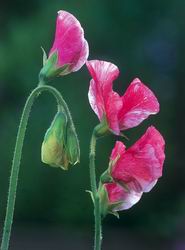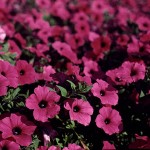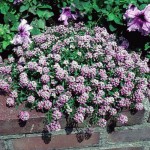September 17, 2006
The possibilities are endless!
- Petunias
- Primrose
- Stocks
- Sweet Alyssum

The best cool weather flowers for your garden are petunias, snapdragons, stocks, calendula, dianthus, alyssum, pansies, primula, sweet peas, and cyclamen. All of the winter annuals except primula and cyclamen do best in raised beds, in full sun. If you do not have a raised bed, enrich the native soil with 2 or 3 inches of compost incorporated into the top 6 inches of soil. Also apply a cup of slow release lawn fertilizer spread over 50 square feet of flowerbed. It is most efficient to water with drip irrigation under 2 inches of a fine organic living mulch. Control slugs and snails with slug and insect bait.
In other climates, petunias are planted for summer color. In Central and South Texas, they perform best as a cool weather seasonal annual flower. Petunias planted now will bloom until late December or until a spell of freezing temperatures. A few selections such as Laura Bush, Wave, and Carpet often live through the winter and bloom again in March through April. Use petunias in full sun. They grow to fill the space available. In containers they drape over the edge and are very attractive as a hanging basket. Petunias are not a favorite deer food, but are eaten in droughty times. The petunias with the strongest “fragrance” such as Laura Bush, are the least favorite with deer.
 Snapdragons are available in purple, red, pink, white, yellow, salmon and some bicolors. Selections range in size from the carpet selections which reach 6 inches to the rocket sizes of 36 inches tall. Use the carpet selections for borders and the medium and tall selections in rows or massed plantings. The tallest snapdragons such as “rocket” are spectacular, but sometimes will be wind damaged unless they are planted in relatively sheltered areas. A good strategy is to plant one plant in a five-gallon container supported by a tomato cage. Snapdragons are not usually eaten by deer and they make good cut flowers. The rocket selections make the best indoor cut flower.
Snapdragons are available in purple, red, pink, white, yellow, salmon and some bicolors. Selections range in size from the carpet selections which reach 6 inches to the rocket sizes of 36 inches tall. Use the carpet selections for borders and the medium and tall selections in rows or massed plantings. The tallest snapdragons such as “rocket” are spectacular, but sometimes will be wind damaged unless they are planted in relatively sheltered areas. A good strategy is to plant one plant in a five-gallon container supported by a tomato cage. Snapdragons are not usually eaten by deer and they make good cut flowers. The rocket selections make the best indoor cut flower.
Stocks also make good cut flowers. The colors are not as intense as snapdragons. They are shorter plants with the flowers somewhat hidden by the foliage. Look for the taller varieties for the most attractive show. The favorite selections in the nursery trade are dwarf plants measuring 8 to 10 inches tall. Stocks have some of the best fragrances in the flower garden.
 If your goal is to warm up the winter garden, consider a butterfly favorite, calendula. They have silver dollar size sunflower-like in shades of yellow or orange. Plants are 10 to 12 inch in height.
If your goal is to warm up the winter garden, consider a butterfly favorite, calendula. They have silver dollar size sunflower-like in shades of yellow or orange. Plants are 10 to 12 inch in height.
 Dianthus is another butterfly favorite. They are also called “pinks.” The blooms are quarter size in variations of pink, white and lavender. Many are bi-colored. Dianthus are the most drought and heat tolerant of the winter annuals. If they are cut back in March, they will often continue blooming through May. Use dianthus in borders or massed plantings. They look good in containers.
Dianthus is another butterfly favorite. They are also called “pinks.” The blooms are quarter size in variations of pink, white and lavender. Many are bi-colored. Dianthus are the most drought and heat tolerant of the winter annuals. If they are cut back in March, they will often continue blooming through May. Use dianthus in borders or massed plantings. They look good in containers.
Alyssum is another fragrant winter annual. The short (6 to 8 inches) rounded plants are ideal for borders in the garden and containers. The lavender or white blooms are tiny, but they cover the plant and perfume the whole garden.
 Pansies are the best flower for winter gardens in Central and South Texas.If you have at least 6 hours of sun reaching the flower bed, they will perform admirably. There are two main types of pansies: clear-faced and monkey-faced. The monkey-faced varieties have a dark blotch in the middle of the face. Pansies are available in blue, yellow, brown, white, maroon, and orange.
Pansies are the best flower for winter gardens in Central and South Texas.If you have at least 6 hours of sun reaching the flower bed, they will perform admirably. There are two main types of pansies: clear-faced and monkey-faced. The monkey-faced varieties have a dark blotch in the middle of the face. Pansies are available in blue, yellow, brown, white, maroon, and orange.
A raised bed is the best place to grow pansies. Native soil works if you enrich it with 2 inches of compost incorporated to 6 inches deep. Add one cup of slow-release lawn fertilizer and spread over 50 square feet of the bed. It does not have to be incorporated into the soil. Plant pansies about one foot apart in the garden. They will have to be watered every day for five days and ever other day for a week. After that, water twice a week or whenever the soil dries to a depth of 1 inch deep. Two inches of mulch helps conserve water and improves pansy performance.
Deer love pansies so don’t plant them where the pests can reach them. Slugs, snails, and pill bugs also eat pansies. To control them, apply slug and snail bait every two weeks. Your pansies will bloom all winter long, and often last until the end of April.
Primulas are also called primrose. They are one of the few blooming plants for use in deep shade. Like pansies and sweet peas, primulas requires cool weather to prosper. They have a growth habit that resembles pansies. The colors of the blooms are more intense than pansies. There is nothing subtle about their color; they make me think of the colors that clowns used to paint their faces at the circus. The leaves are crinkled and lay close to the ground. Slugs and snails like primulas better than pansies. Do not plant them unless you are willing to apply snail and slug bait immediately.
 All of the flowers described so far are easy to grow, however sweet peas are more difficult. The bloom colors are as diverse and intense as snapdragons. The fragrance is different from stocks, but nearly as pleasing and they make wonderful cut flowers. The best sweet pea selections are vines that do well on trellises. Some bush varieties are available. What makes sweet peas hard to grow is that they are sensitive to extreme cold and heat. They do best in climates with moderate temperatures between 40º F and 70º F. In our climate, you have to reseed several times in a typical winter before the plants live long enough to bloom.
All of the flowers described so far are easy to grow, however sweet peas are more difficult. The bloom colors are as diverse and intense as snapdragons. The fragrance is different from stocks, but nearly as pleasing and they make wonderful cut flowers. The best sweet pea selections are vines that do well on trellises. Some bush varieties are available. What makes sweet peas hard to grow is that they are sensitive to extreme cold and heat. They do best in climates with moderate temperatures between 40º F and 70º F. In our climate, you have to reseed several times in a typical winter before the plants live long enough to bloom.
Sweet peas are planted by seed. During some winters in San Antonio, we have had to plant and replant them several times November through February in order to establish a stand. The problem with sweet peas is that they not only do not like hot weather, but they cannot tolerate freezing temperatures. They prosper in cool weather without extremes in either direction. If you wonder why anyone would bother, there are at least two reasons: the beauty and the fragrance of the blooms. Sweet peas produce a color range from the most delicate pastels through the most intense primary colors. Pink, red, yellow, white, and blue are the most common colors. The fragrance is distinctive and sweet. You can enjoy the fragrance by being near the sweet pea bed or if you use the blooms as cut flowers. Sweet peas are long-lived cut flowers.
There are some bush sweet peas, but the most impressive varieties are vines. The vines require a trellis. Tomato cages work well, but if you make a tepee lean-to or an upright structure, the bloom display is even more impressive. Plant the seeds right now at the base of your tomato cages. When the weather cools enough that the tomatoes quit producing, the sweet peas will grow over the cages.
It is very important that the sweet peas be mulched, because the roots are shallow and do not tolerate drying out. Two inches of a rich organic compost work well as mulch for sweet peas.
So to review, use pansies for a low-growing blooming plant in full sun this winter. They are very cold tolerant and easy to grow in San Antonio. Use primula in deep shade for a pansy-like bloom. If you are up for a challenge, seed sweet peas to grow on your tomato cage or other trellis.
 Last but not least, consider planting cyclamen. Cyclamen has a leaf that is lush as spinach and it also should be planted in November, but that is where the similarity ends. Cyclamen is an all-star winter blooming plant for the shade. You won’t eat it, but you will admire cyclamen. The blooms are red, white, pink, or maroon. The flowers stand above the attractive 3-inch heart-shaped leaves on stalks that reach about 1-foot tall. Unless the weather gets extremely cold, cyclamen will have blooms every day, all winter, until April. Use cyclamen as specimen plants or massed as a single color or in a combination of white and any of the other colors.
Last but not least, consider planting cyclamen. Cyclamen has a leaf that is lush as spinach and it also should be planted in November, but that is where the similarity ends. Cyclamen is an all-star winter blooming plant for the shade. You won’t eat it, but you will admire cyclamen. The blooms are red, white, pink, or maroon. The flowers stand above the attractive 3-inch heart-shaped leaves on stalks that reach about 1-foot tall. Unless the weather gets extremely cold, cyclamen will have blooms every day, all winter, until April. Use cyclamen as specimen plants or massed as a single color or in a combination of white and any of the other colors.
Cyclamen are not inexpensive plants. Cyclamen are available in 4-inch containers on up. The larger the plant, of course, the more they cost. Four-inch plants may cost $5. They are very beautiful and worth the investment, but the key to reducing costs is to over-summer a portion of your plants. Cyclamen does not like heat so the task is not always easy.
Some gardeners remove the bulb structure from the garden in late April or early May to store in a paper sack in an air-conditioned room in the house. Also, try leaving the plants in a container and storing them in the house without watering them. The most effective tactic so far has been to grow the cyclamen in containers sunk in the flower bed all winter. In the the summer, plant them around caladiums or other shade-loving plants. It also works to store the containerized plants in a shady corner of the yard where they can be watered once every two weeks. Replant the survivors in the flower bed, and be generous with the time-released fertilizer incorporated in the soil at the time of planting. The new plants you purchase are in full bloom and pumped up with nutrients, so your over-summered plants will require some special attention to catch up.
Many of us have grown cyclamen as a houseplant. Cyclamen will live a number of years and bloom almost continuously if they are watered faithfully when the soil surface dries to half an inch, is fertilized every three or four weeks with soluble fertilizer, and placed in a window with morning sun. In the air-conditioned house cyclamen is much more tolerant of light than they are outside. In the late fall through early spring, cyclamen do best with dappled sun for a few hours each day.
So what are you waiting for? Get out there and buy some cool weather colors plants for your landscape and…
Remember, Learn and Have Fun!
David Rodriguez is the County Extension Agent-Horticulture for Bexar County. He represents Texas Cooperative Extension with the Texas A&M University System. For any landscape or gardening information, call the Bexar County Master Gardeners Hotline at (210) 467-6575, email questions to mg-bexar@tamu.edu, or visit our County Extension website at http:bexar-tx.tamu.edu
Special Note: Listen “live” with David Rodriguez every Saturday morning between 8:00- 11:00 am on WOAI 1200 AM Gardening Show. Feel free to call in at 737-1200 or 1-800-383-9624. Check it out!



